Last updated on December 31st, 2023 at 06:01 pm
Hi everyone, I hope you are having a wonderful day!
In this post, I will describe a couple of the best portable recorders that also have XLR inputs, since most of the ones available on the market only provide the included microphones.
I will be listing them from the highest XLR input count to the lowest.
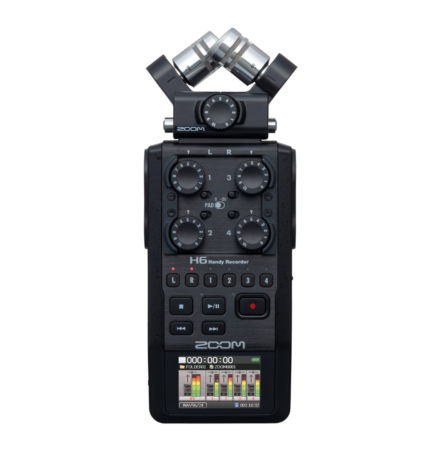
Zoom H6
Best Portable recorder that can record up to 6 XLR inputs.
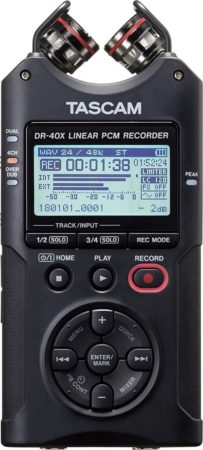
Tascam DR 40X
Cheap alternative that offers 2 XLR inputs and works as an Audio Interface.
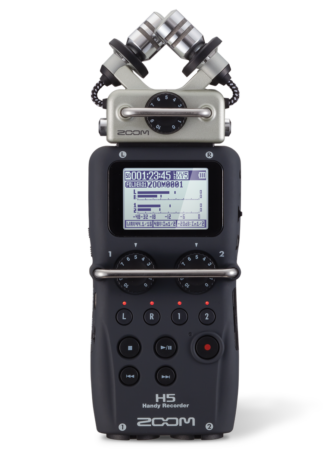
Zoom H5
Best all-rounder: 2 XLR inputs and multiple capsules to choose from.
Best Portable Recorders with XLR Inputs
Let’s kick things off by starting with the absolute best portable recorder, the Zoom H6.
Zoom H6
Best Portable recorder ever made!
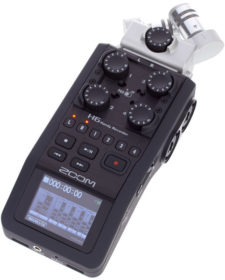
The Zoom H6 recorder feels like a recording studio in the palm of your hand, this is because it allows for simultaneous 6-track recording while also providing a great interface that looks a bit like a tiny DAW.
The quality of the audio it captures is top-notch and it can record directly into the device itself or it can work as an Audio Interface, allowing you to record multitracks onto your computer’s DAW.
Straight out of the box you get; The Zoom H6 Recorder, the transporter case/box which actually is quite big and of good quality, The XYH-6 and MSH-6 Capsules (which have their own gain controls), four AA Batteries, a Pop filter, a USB Cable, a 2Gb SD card and an SD Card Reader.
Like most Zoom Recorders, this one comes with a Cubase LE installation Key.
There are some other Capsules available for the Zoom H6; the EXH-6, SGH-6, and SSH-6, all with their own Gain Control Knob, and all of them are interchangeable.
The interface this recorder provides is the best I’ve seen yet since it’s not black and white like most of them are. This one is colored and it makes it really easy to see what is going on.
What makes this Recorder great?
It can record up to 6 simultaneous tracks at an excellent quality which is great either for recording multiple instruments, musicians, or podcast members. It gives you a lot of versatility.
It works as an Audio Interface: Even though you don’t need a computer to record audio when you have the H6, you could still use this recorder as an Audio Interface to record directly onto your DAW with multiple microphones.
You will need to download the drivers from the Zoom website to be able to use the recorder this way though. Here’s the link to the official download page.
The Interface of the Zoom H6 is fairly simple and straightforward to use, even if you are not a pro you will still find that it’s very intuitive.
Inputs
All of the Zoom H6 inputs are combo connectors that can accept either XLR or ¼” balanced or unbalanced cables and they can handle both mic- and line levels, which means that you can connect either external microphones or line-level devices such as mixers, electronic keyboards, etc.
Also, you can use the interchangeable capsules which provide you with either a Shotgun, X/Y, Mid-Side, and a Stereo Shotgun microphone, and the EXH-6 Capsule gives you the ability to connect two extra external microphones.
The last input you get is an additional 3.5mm jack on the stereo X/Y capsule.
Included Microphone Capsules
The Stereo X/Y (XYH-6): These are actually two cardioid microphones set up in an X/Y pattern.
You can control how much of a stereo image you want to pick up by adjusting the angle. It can go from 90 degrees all the way to 120 degrees.
If you don’t have any external microphones, you can always use the X/Y capsule and place the recorder in front of the sound source.
The Mid-Side (MSH-6): This capsule also has two built-in microphones, one cardioid, which is facing forward, and one with a figure “8” pattern, which picks up sound from the sides.
This one is great because it allows you to control how much of a stereo image you want by increasing or lowering the volume of the side microphone, and this can also be done after recording, in the DAW with a plugin you can download from the Zoom Website.
If you want to know more about the Mid-Side recording technique, make sure to read this article I wrote on that topic!
The Zoom H6 has a Headphone jack on its side, which allows for monitoring and has its own volume control.
It can also be attached to a camera with a Hot Shoe mount and via the line out jack, it allows you to send the audio to the camera.
Lastly, it comes with a remote-control jack (the remote is not included).
Recording Quality
The Zoom H6 can record either MP3 or WAV formats.
The highest recording quality is 24-bit/96kHz. Just remember that the higher the quality, the more storage it will take up!
Extra Features
- Low cut filter: This will help you reduce some of those unwanted lower frequencies such as popping or wind noise.
- Compressor and Limiter: These will help with raising lower level input signals but also with lowering higher input signals, basically making the recording sound more uniform.
- Phantom and Plug-In Power: This is used to power external microphones which require Phantom Power, like condenser microphones.
- Normalize, Divide and Trim editing.
- Cubase Le and WaveLab LE keys included.
- Dual Recording: This allows you to record a second set of tracks at -12dB in case the original ones clip!
Why you might need it?
I would absolutely recommend this recorder if you are planning on recording multiple sound sources. If you have no need for 6 inputs, then maybe one of the other ones on this list will be best for you!
Still, I think that the Zoom H6 is the best one on this list simply because of its versatility and overall quality!
One added bonus of the Zoom H6 is the interchangeable capsules.
Find out more about the Zoom H6 here;
- Zoom H6: Amazon, Sweetwater.
Tascam DR40
Portable Recorder with 2 XLR Inputs and very cost-efficient!
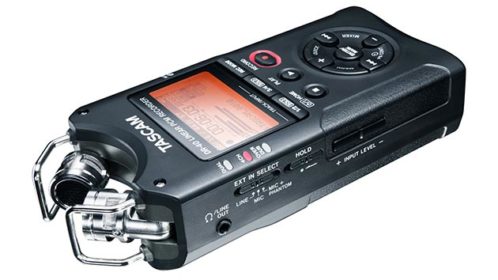
The Tascam DR40 has two condenser cardioid microphones that can be moved around independently from each other, being able to record in A/B (which gives a nice stereo image) and X/Y positions.
It also provides two XLR inputs on the bottom, which can provide phantom power for external microphones.
It offers four different recording modes:
- The standard mono/stereo uses either the onboard or XLR mics.
- And the Dual, Four-channel, and Overdub modes.
Each channel has its own parameters/effects:
- Dual has the “Peak Reduction, auto level or Limiter” Option
- Four-channel has a delay
- Overdub has “Separate” and “Mix” options
One drawback of this recorder is that it doesn’t work as an Audio Interface, it only works as a standalone recorder.
Update: Tascam recently released a new version of the DR-40 which is the Tascam DR-40X.
This one is exactly the same recorder in every way except that it also works as an Audio Interface.
What makes this Recorder great?
Just like with the Zoom H6 and H5, the Tascam DR40 can dual record, this means that it records at the volume that you dial in, but also records simultaneously at a lower gain, 12dB to be precise.
This is great because should the first recording be too loud and clip, then you have a backup one that doesn’t sound distorted!
Added to the two XLR inputs on the bottom, you get the capsules on the top of the recorder which can be used both as X/Y and A/B patterns.
It’s also way cheaper than the first ones on this list!
Inputs
The Tascam DR40 provides Dual combo XLR/TRS inputs that can handle both mic- and line-level signals, allowing you to connect external microphones and line-level devices.
It also provides MS (Mid-Side) decoding function making it possible to use M-S microphones
Recording Quality
When It comes to the file formats it’s able to record BWF and WAV at 44.1k/48k/96kHz, 16/24-bit and MP3 from 32kbps all the way up to 320kbps.
Extra Features
- Peak reduction function that detects peaks and automatically sets the optimal level
- Reverb effect
- 3 low-cut filter presets, 40Hz, 80Hz and 10Hz.
Why you might need it?
The Tascam DR40 offers great value, it only costs about a third of what the H6 costs.
So, if budget is an issue or if you don’t need a huge amount of inputs, then I would definitely recommend it!
Find out more about the Tascam DR40 here:
- Tascam DR40: Amazon, Sweetwater.
Zoom H5
Portable Recorder with 4 XLR Inputs and multiple capsules!
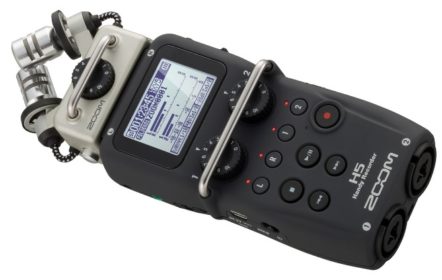
The Zoom H5 was introduced in 2014 and hasn´t been physically updated ever since, which is a testament to its all-around good quality.
The Zoom H5 can record up to four simultaneous tracks, and just like the H6 it can record them onto its own internal storage or it can be used as an Audio Interface.
The two XLR inputs are on the bottom of the recorder.
Straight out of the box you get the recorder, user manual, the transporter case (which lies more on the cheap side), Two AA Batteries, a Pop-Filter, USB Cable, and 2gb MicroSD card With the MicroSD Adapter (supports up to 32gb).
The recorder doesn´t feel at all cheap, it has a rubber-like feel to it and is pretty heavy, which is something that I like.
Just like the H6, the Zoom H5 Supports Zooms Interchangeable Microphones (MSH-6, EXH-6, XYH-6, SGH-6, and SSH-6) which you can get separately, except for the XYH-5 mic which comes with the recorder.
This one is different from the XYH-6 in that the angle can’t be adjusted.
One cool difference between the H5 and the H6 is that it has a metal rail covering the gain knobs, which makes it a lot harder to change the gain settings accidentally, for instance, if you were carrying it in your bag/pocket.
The included capsule (XYH-5) has two shock-protected microphones and even has a line-in option, should you need to connect an external mic.
The interface isn’t that great when compared to the H6.
The screen is black and white and you can’t read the levels as fast as on the H6, but it’s still very manageable!
What makes this Recorder great?
The advantages of this recorder are identical to the ones of the H6, the only difference is the number of simultaneous tracks it can record.
But it still works as an Audio Interface, if you are using the Mid-Side capsule you can use the Mid-Side decoder to adjust the stereo field to your liking. Remember to download the plugin from their official website!
Inputs
The Zoom H5 provides Dual combo XLR/TRS inputs that can handle both mic- and line-level signals which allow you to connect external microphones and line-level devices like mixers, effects processors, and electronic keyboards—even electric guitars or basses equipped with active pickups.
Included Microphone Capsules
The only included capsule is the XYH-5, which is similar to the one included on the H6, the only difference is that the angle can’t be adjusted, it’s set at 90 degrees.
This capsule also provides a secondary input for connecting a mic or line-level signal via a 3.5mm jack.
All of the capsules available for the H6 can be also purchased for the H5.
If you want to be able to record 4 tracks simultaneously you will need to buy the EXH-6 one, which gives you two extra XLR inputs.
The Zoom H5 has a Headphone jack on its side, which allows for monitoring and has its own volume control.
It can also be attached to a camera with a Hot Shoe mount and via the line out jack, it allows you to send the audio to that camera.
Recording Quality
The maximum recording quality is 24-bit/96kHz WAV files, but it can also record in MP3.
Extra Features
- Low-cut filter.
- Compression and Limiting.
- Cubase Le and WaveLab LE Keys included.
- Normalize, Divide and Trim editing.
- Can provide Phantom Power to the XLR inputs.
- Dual Recording: This allows you to record a second set of tracks at -12dB in case the original ones clip!
Why you might need it?
If you need a portable recorder that will give you excellent recording quality at a fair price with up to four inputs, the Zoom H5 is definitely a great investment!
Also, being able to purchase the other capsules is a great bonus since it adds versatility.
Find out more about the Zoom H5 here:
- Zoom H5: Amazon, Sweetwater.
Tascam DR-70D
Portable Recorder with 4 XLR Inputs!
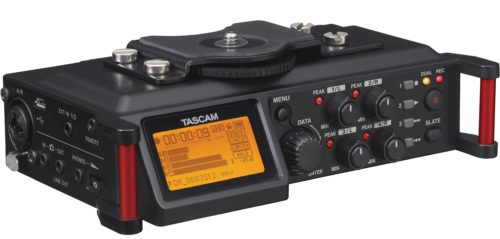
The DR-70D is most commonly used by filmmakers, but it’s also a great option for musicians!
It has a pair of built-in microphones that can capture sound, but if you want to get really high-quality recordings you will need to use external ones.
This recorder has four balanced XLR mic inputs and it can provide Phantom Power if you decide to use Condenser Microphones!
Each input has a limiter, delay, and a low-cut filter available for controlling volume.
It also includes Dual Recording mode, which records a copy of your audio at a lower level to prevent distorted takes.
The recorder has tripod mounts on the top and bottom, which allows you to mount it on a camera, a follow-focus cage, or to use it as a standalone unit.
The screen is black and white, but it shows all the information you really need.
The four inputs allow you to record up to four different tracks simultaneously.
Channels 3 and 4 can be set to the built-in microphones, but you can’t use the four inputs with external mics plus the 2 built-in ones at the same time.
A 3.5mm mini-jack is also provided which can supply plug-in power.
Like all other recorders on this list, the Tascam DR-70D comes with a headphone jack that allows for monitoring and has its own volume control.
Just like the Tascam DR-40, this recorder doesn’t work as an Audio Interface.
What makes this Recorder great?
It’s especially good for filmmakers since it can be easily attached to the camera, but if you want to record music on it… it will definitely be able to do it!
The Tascam DR-70D also has the dual record option, which means that it records at the volume that you dial in but also records simultaneously at a lower gain, should the first recording be too loud and clip.
Inputs
It provides four combo XLR/TRS inputs that can handle both mic- and line-level signals plus the two built-in omnidirectional stereo microphones, which are at the back of the recorder.
These omnidirectional microphones are good for recording ambient sound while you focus the main sound source with an external one.
Recording Quality
When It comes to the file formats it’s able to record BWF and WAV at 44.1k/48k/96kHz, 16/24-bit.
Extra Features
- Limiter, delay, and a low-cut filter.
Why you might need it?
As I stated earlier, the Tascam DR-70D was designed with filmmaking in mind.
It’s very compact and can be attached on top or under any camera.
It still works great for musicians though but in that case, I would recommend either the Zoom H5 or the Zoom H6.
Find out more about the Tascam DR-70D here:
- Tascam DR-70D: Amazon, Sweetwater.
Marantz Professional PMD-561
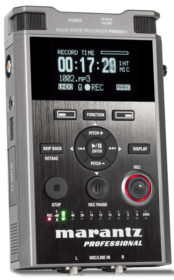
The Marantz PMD-561 is a great audio recorder that records directly onto the SD/SDHC flash media.
It’s actually quite compact and its main use is for reporters and for in-field recordings, but since it has two XLR inputs which deliver great sound quality, it can be used for musicians and filmmakers as well.
It’s not as small as they advertise it to be, but it is still very comfortable to use!
It includes a built-in high-quality stereo condenser microphone array, switchable balanced Mic/XLR line inputs, as well as unbalanced line outputs on RCA connectors, and a secondary unbalanced line input on a 3.5 mm mini-jack connector.
The screen is black and white, but it will show you all the information you need, still… no recorder beats the H6 in this department.
The Marantz Professional PMD-561 can provide Phantom Power for your condenser microphones.
What makes this Recorder great?
It’s easy to see everything that’s being displayed on the screen, even if you are looking at it in direct sunlight.
The preamps definitely sound great, they may be a bit noisy but they sound very warm and accurate.
This recorder is usually compared to the Tascam DR-100mkiii, which is actually a much more expensive one… I think that this is a pretty good deal, considering that you’re paying almost half as much!
Inputs
It has two combi XLR ¼” inputs for mic and line-level signals plus a 3.5mm line input.
Recording Quality
It can record 16-24 bit / 44.1, 48 and 96kHz WAV and 192kbps to 32kbps MP3.
Extra Features
- On-board pitch-shifting buttons to speed/slow playback
- Password-protected file encryption
- High cut filter
Make sure to check the current price of the Marantz PMD-561 on Amazon.
Conclusion
No matter which recorder you decide to go for, they are all extremely good quality and will allow you to create amazing recordings!
I would definitely choose the Zoom H6, simply because you can purchase the extra capsules plus it has four extra XLR inputs.
It is, by far, the most versatile recorder on this list.
However, if you just want to record one or two tracks, or if you don’t want to spend a lot of money, then my second pick would be the Tascam DR40.
I hope this information helped, see you on the next one!
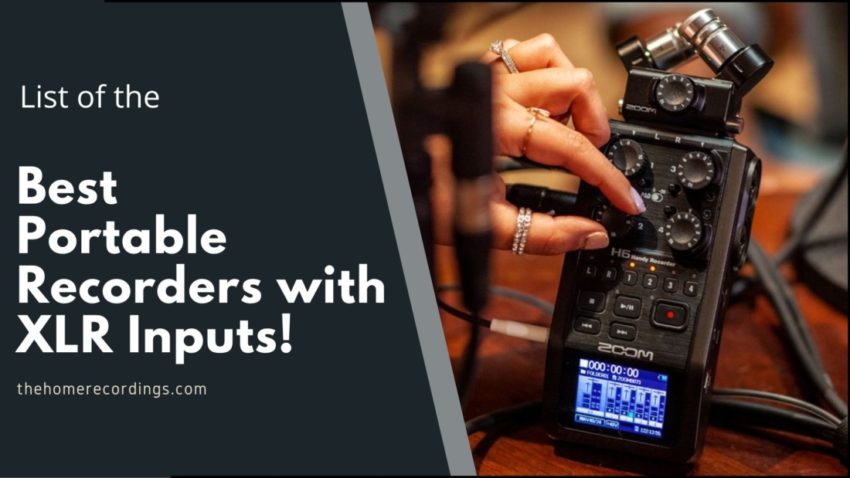
One thing to note is the use of that rubberised coating on some of these things. It turns to sticky black goop eventually. I have an H6 that did this and also a Roland R09HR. I’d recommend avoiding any equipment that uses this stuff. However when it does happen the coating can be removed using isopropyl alcohol leaving the plastic shell underneath, without the stickiness.
Mic preamps on these devices can also be very noisy, particularly when using gains over 40dB with field ambient recordings. Best way to handle this is to use decent outboard condenser mics (eg Rode NT4) that have a reasonably high output already.
Great material: Please help. I am looking a low cost recorder that will allow me to record from an audio source, no voice. I seem confused what is a available, audio input for example desktop audio thank you